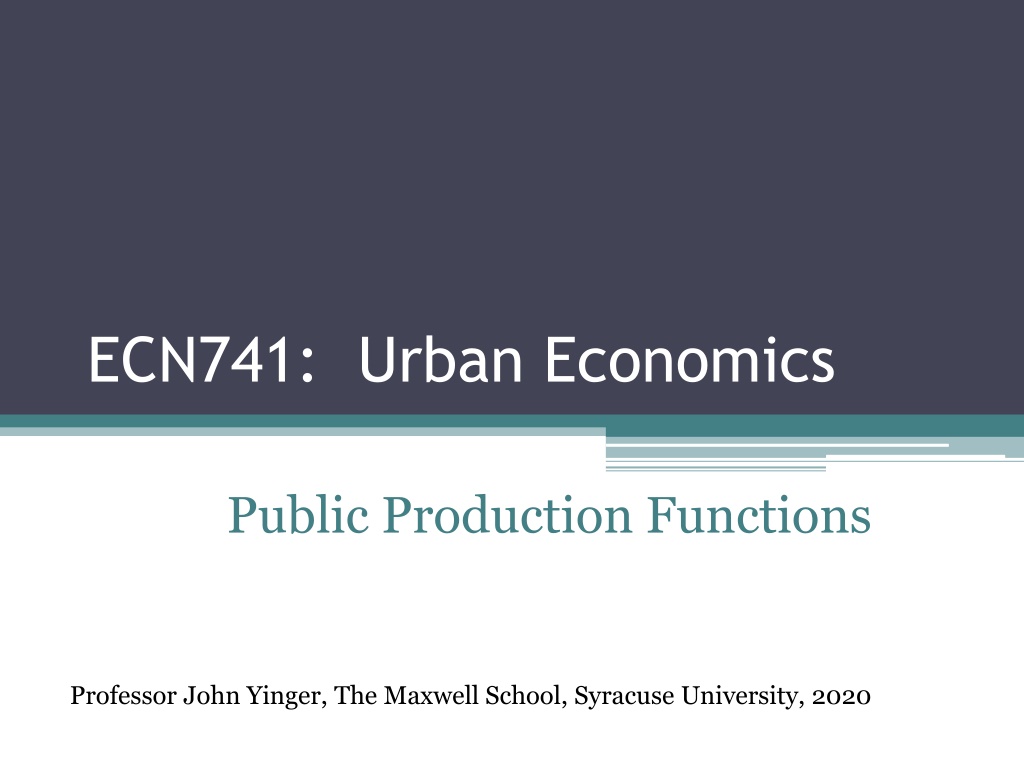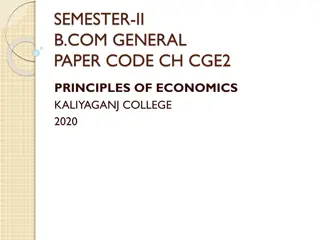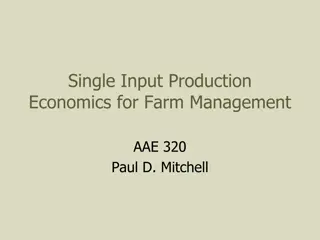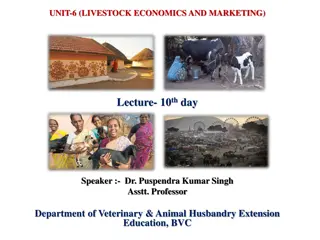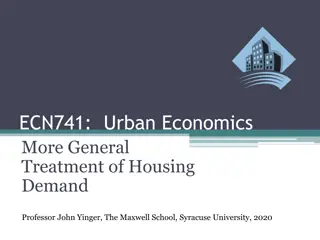Understanding Urban Economics: Production Functions in Public Services
Production functions play a crucial role in analyzing the technology behind public production, with a focus on education production functions. Scholars and policymakers delve into the methodological complexities to comprehend the relationship between inputs like capital and labor and outputs like quality of services provided. Varieties of production functions like Cobb-Douglas are used to measure scale effects and efficiency in different sectors such as fire services and education. Fixed effects are essential in capturing unobservable factors in education production functions.
Download Presentation

Please find below an Image/Link to download the presentation.
The content on the website is provided AS IS for your information and personal use only. It may not be sold, licensed, or shared on other websites without obtaining consent from the author. Download presentation by click this link. If you encounter any issues during the download, it is possible that the publisher has removed the file from their server.
E N D
Presentation Transcript
ECN741: Urban Economics Public Production Functions Professor John Yinger, The Maxwell School, Syracuse University, 2020
Production Functions Class Outline The Algebra of Production Functions Alternative Approaches to Education Production Functions Examples
Production Functions Why Production Functions? Scholars and policy makers often want to understand the technology of public production. The basic idea of a production function is simple, but it turns out that production functions raise an astonishingly large number of methodological issues. Different scholars make different decisions about what is important. I hope to give you a sense of some key trade-offs today, with a focus on education production functions.
Production Functions Definition A production function translates inputs, sayK andL, into an output, say Q. A simple form (Cobb-Douglas): Q AK L Q = = a b or + + ln{ } ln{ } ln{ } ln{ } A a K b L Ifa + b = 1, the function has constant returns to scale (as measured by Q, not population).
Production Functions Duncombe and Yinger Bill and I took a look at production functions for fire services in NY (J. Public Economics 1993). We measure output by fire losses as a share of property value We identify 2 key measures of scale Service quality (i.e. level of output) The number of people served We find Increasing returns to quality scale (cost per unit of quality goes down as quality goes up) Constant returns to population scale (cost per capita is constant as population changes)
Production Functions Education Production Functions t T = 1 T t = + + + + + ( ) Y X X ijt i ijT ijT jT T ijT = 1 t Y = student test score i = student; j = school; t = year; T = current year X = inputs (= student, school, teacher traits) = student fixed effect (fe) = school, grade/school, or teacher fe = year fe = parameter to measure degrading of skills = random error
Production Functions Education Production Function Notes Note that the fixed effects are designed to capture unobservable factors. Different fixed effects require different data structures. Student fe s cannot be estimated with a single year of data because there would only be one observation for each student. School or teacher or grade/school fe s can be estimated with a single year of data and they are compatible with student fe s because students change schools and teachers. As we will see, the key is to be clear about the question you want to ask and then to use the most general approach that is possible with your data.
Production Functions Production Function Form t T = 1 T t = + + + + + ( ) Y X X ijt i ijT ijT jT T ijT = 1 t This linear form is the starting point in most studies. This form is not consistent with production theory but works well and is easy to estimate. Expressing X and Y in logs (rarely done) is the same as the Cobb-Douglas form given earlier.
Production Functions Production Function Form, 2 However, even the assumptions behind a Cobb-Douglas form can be rejected. See David Figlio, Functional Form and the Estimated Effects of School Resources, Economics of Education Review, April 1999, pp. 241-252. Using a general form (trans-log) changes the answer! Figlio finds that a general form, unlike a linear form, leads to significant (but not large) impacts of school resources on student outcomes. But linear forms still dominate because they are simple to estimate and do not require such large sample sizes. These are the kind of trade-offs you will have to make in your own research!
Production Functions Estimation Strategy 1, No FEs Assume = =0 (= no fe s!). Subtract equation for Yij(T-1) to eliminate summation. Lagged Y should be considered endogenous because it is correlated with ijT-1, but some studies ignore this. Requires 2 years of data for Y (and a lagged instrument). = + + ) ( + ( ) Y X Y ijT ijT T ijT 1 1 1 ijT T ijT
Production Functions Estimation Strategy 1, Continued The big problem with this strategy, of course, is that (with only 2 years of data) it assumes away student fixed effects (or else changes their meaning to be something that fades over time at rate ). Traits such as motivation cannot be observed, but they both influence performance and are correlated with included explanatory variables. This strategy is more credible if a study has a large number of control variables for student traits (or a long panel).
Production Functions Estimation Strategy 1A Add school, school/grade, or teacher fe s to Strategy 1. One must be able to link students to schools or school and grade or (rarely possible) teachers. This gets away from the assumption that =0, But still does not estimate student fixed effects. With a longer panel, one could use school-by- year fixed effects (or school/grade by year).
Production Functions Estimation Strategy 1B? The literature assumes that is the same for all students. But this does not appear to be the case: higher-income students go to math and music camp! This issue could be introduced with interactions between Yij(T-1) and various student traits. There may be a study that does this, but I have not come across it (= research opportunity!).
Production Functions Variation in Learning A related point is that the coefficient of interest, , may also depend on student traits, including traits picked up by the fixed effects. Addressing this problem is beyond the scope of these notes. I also do not consider systematic measurement error in Y, which is addressed in some articles.
Production Functions Strategy 2, Complete Degrading Assume = 0 (complete skill degrading). Specify equation in difference form. Student ( ) fe s drop out (= are accounted for). School fe s may drop out, but not school/grade or teacher fe s (not included in equation below). Requires 2 years of data for X and Y. The term is the constant. = ) ( + ) ( + ( ) Y Y X X ijT ijT T ijT 1 1 1 1 ijT ijT T ijT
Production Functions Strategy 2, Continued Note that the student fe s account for all student unobservables and X s before year T-1. The problem comes in year T-1. The form of the X variables for period T-1 in the estimating equation is based on the assumption that = 0. So these explanatory variables are mis-specified if there is not complete skill degrading. Also, with student fe s, the coefficients are estimated based solely on variation over time, which may be limited, especially with only 2 years of data.
Production Functions Strategy 2A Add school, school/grade, or teacher fixed effects. Requires better data. Still assumes no degrading of skills.
Production Functions An Aside on Value Added The change in a student s test score from one year to the next is called the value added. But the term is not used consistently. Some people (e.g. one study discussed below) say they are estimating a value added model when they introduce a lagged test score (Strategy 1). Other say a value added model is equivalent to differencing test scores (Strategy 2). Whatever terminology you prefer, make sure your assumptions about degrading are clear!
Production Functions Differencing vs. Fixed Effects With a two-year panel, first-differencing and the use of student fixed effects are equivalent techniques. With a longer panel, they are not quite equivalent. A fixed-effects model has a clearer interpretation and is generally preferred in the education literature. There are some technical issues regarding standard errors, which I am not going to cover. So when I say difference, I really mean fixed effects when the panel is longer than 2 years.
Production Functions Strategy 3, No Degrading Assume = 1 (no degrading ever!!). Specify the equation in difference form. Student ( ) and perhaps school ( ) fe s cancel out; school/grade or teacher fe s do not (omitted here). Requires 2 years of data for Y. 1 ( ijT ijT ij T t t T X = t T = = + + + + + ) Y Y X X ijt i j T ijT ( 1) = 1 = 2 + + + + + ( ) X ijt i j 1 T ( 1) ( 1) ij T ij T 1 t + ) ( + ( ) X X X = + ijT T ijT 1 1 T ijT ( 1) ( 1) ij T ij T = ) ( + ( ) X + ijT T ijT 1 1 T ijT
Production Functions Strategy 3, Continued The problem with this strategy is similar to the problem with strategy 2 it mis-specifies the X variables unless its assumption of = 1 is correct. The student fe s account for all time-invariant student traits and all X variables before year T-1. However, without the no-degrading assumption, the X variables for the year T-1 belong in the equation.
Production Functions Reinterpretation of Strategy 3 Some people interpret this set-up as regressing value added on current student and school traits. Hence unobserved student, school, and teacher traits are interpreted as part of current factors. Under this interpretation student fe s do not cancel, and panel data are needed. Teacher fe s obviously still are relevant. This approach also completely flips the assumption of skill degrading because it ignores past X s, which is equivalent to assuming that = 0.
Production Functions Strategy 4, Great Data! Estimate a differenced value-added model. Accounts both for degrading and student fe s. Requires 3 year of data (including 2 for instrument). t T = 1 T t = + + + + + ( ) Y ij T Y X X ijt i j ijT ijT T ijT ( 1) = 1 t t T = 2 + + + + + ( 1) T t ( ) X X ijt i j 1 T ( 1) ( 1) ij T ij T = 1 t X X X = + ijT ( 1) ( 1) ij T ij T t T = 2 + ) ( + ) ( + ( 1) T t ( 1) ( ) X ijt T ijT 1 1 T ijT = + 1 t = + + Y X Y ijT ijT 1 ijT ( ( ) ( ) ( ) T 1 1 2 T T T ) ( ) ( ) ijT 1 ijT ( 1) ( 2) ij T ij T
Production Functions Stiefel, Schwartz, Ellen Production Function Study of the Black-White Test Score Gap (JPAM 2007) Great NYC Data (70,000 students!). Estimation Strategy 1A ( = 0.6). Several endogenous variables. Uses fe at school and classroom level. Preferred models add lagged Testij to right side.
Production Functions Stiefel, Schwartz, Ellen, Results A large share of the black-white and Hispanic- white gaps in test scores is explained by the control variables. But a significant gap remains. Their Table 2 is just raw differences. Their Table 4 uses Strategy 1 (columns 1 and 4) or Strategy 1A (columns 2, 3, and 5). Columns 2 and 5 use school fe; column 3 uses classroom fe.
Production Functions Stiefel, Schwartz, Ellen, Results 2 So adding student characteristics and lagged test score makes a large difference. The black-white gap, for example, goes from a z-score difference of 0.776 in 8th grade reading to a difference of 0.250. School or classroom fixed effects do not alter this result very much. The black-white gap goes from 0.250 to 0.201. Student-level fixed effects (not estimated) might also matter. No endogeneity correction, which might also matter.
Production Functions Grade Span Other papers with a similar methodology, the same data, and some overlap in authors are: Amy Ellen Schwartz, Leanna Stiefel, Ross Rubenstein, and Jeffrey Zabel. 2011. The Path Not Taken: How Does School Organization Affect Eighth-Grade Achievement? Educational Evaluation and Policy Analysis 33 (3) (September): 293 317. Amy Ellen Schwartz, Leanna Stiefel, and Michah W. Rothbart. 2016. Do Top Dogs Rule in Middle School? Evidence on Bullying, Safety, and Belonging. American Educational Research Journal 53 (5) (October): 450 1484. Students do better, it turns out, in schools with longer grade spans.
Production Functions Rivkin, Hanushek, and Kain An influential production function study: S. G. Rivkin, E.A. Hanushek, and J.F. Kain. Teachers, Schools, and Academic Achievement. Econometrica, March 2005, pp. 417-458. Great data for Texas; > 1 million observations. Students linked to grades and schools Strategy 3A. School by year and school by class f.e. Assumes no degrading.
Production Functions Rivkin, Hanushek, and Kain, 2 Their initial set-up is: Their final estimating equation is:
Production Functions Rivkin, Hanushek, and Kain, 3
Production Functions Rivkin, Hanushek, and Kain, 4 This paper finds significant, but small impacts of class size and teacher traits on value added. It is famous because it uses fixed effects to isolate the impact of unobserved within-school variation (= teacher quality) on student performance and shows that it has a large impact. Other studies have matched students to teachers and replicate this result with teacher fe. J.E. Rockoff, The Impact of Individual Teachers on Student Achievement: Evidence from Panel Data, American Economic Review, May 2004, pp. 247-252, uses Strategy 2A.
Production Functions Teacher Fixed Effects This literature on teacher fixed effects led to a revolution in education policy. Teacher fixed effects were estimated in many states and the results used to reward or sanction teachers. It seems to me that policy got ahead of research. Some studies showed that teachers with higher fixed effects generate higher student performance, but there was no clear evidence that a system to reward such teachers made led to student performance gains. The federal government weakened its requirements and many states, including NY, have now backed away from evaluating teachers based on their fixed effects.
Production Functions Teacher Fixed Effects, 2 The literature on teacher fixed effects is beyond the scope of this class, but here are a couple issues to investigate if you are interested in this topic: Teacher fixed effects have to be estimated. Methods and available data differ. Is it possible to estimate reliable teacher fixed effects with data available in most states? Teacher fixed effects can be included in an accountability scheme in many different ways. Should they be used for tenure decisions? Should they affect annual raises? Can they lead to equitable treatment across teachers with different types of teaching assignments?
Production Functions Teacher Fixed Effects, 3 A couple of citations on the topic: Douglas N. Harris, Tim R. Sass. 2014. Skills, productivity and the evaluation of teacher performance. Economics of Education Review 40: 183 204 Tim R. Sass, Anastasia Semykina, Douglas N. Harris. 2014. Value-added models and the measurement of teacher productivity. Economics of Education Review 38: 9 23. The latest evidence indicates that basing teacher rewards on test-score gains will not boost student achievement: https://www.rand.org/pubs/research_reports/RR2242.ht ml
Production Functions Questions What is a public production function and how can it be estimated? How can one account for individual fixed effects in an education production function? How can one account for past events in an education production function? What is value added in an education production function? What do different approaches to education production functions assume about skill degrading.
